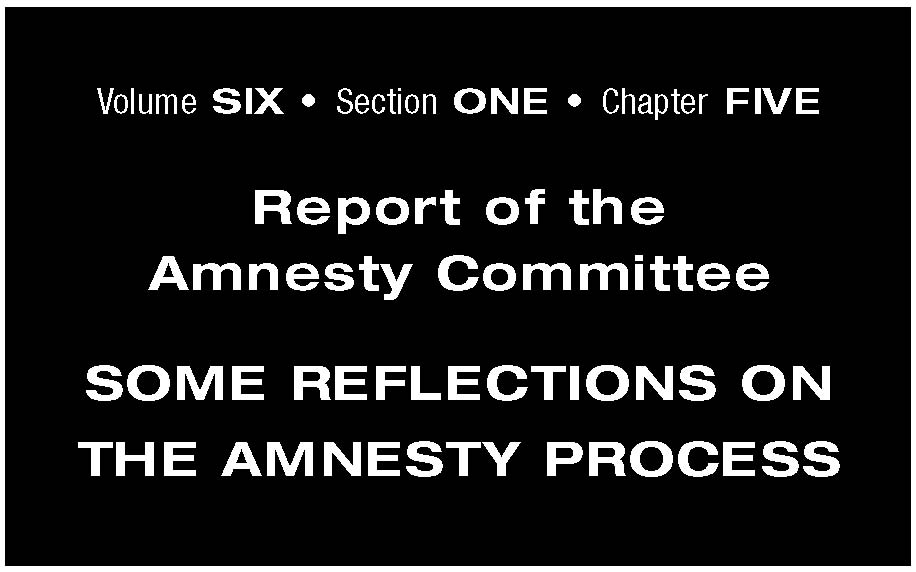 |
News | Sport | TV | Radio | Education | TV Licenses | Contact Us |
 |
News | Sport | TV | Radio | Education | TV Licenses | Contact Us |
TRC Final ReportPage Number (Original) 83 Paragraph Numbers 1 to 10 Volume 6 Section 1 Chapter 5 Subsection 1  Volume SIX Section ONE Chapter FIVE Some Reflections on the Amnesty Process1. As was noted in Chapter Two of this volume, the South African amnesty process was unique in that it provided not for blanket amnesty but for a conditional amnesty, requiring that offences and delicts related to gross human rights violations be publicly disclosed before amnesty could be granted. This meant that the Amnesty Committee (the Committee) set sail in uncharted waters, with no international or local precedents to guide it. 2. Nobody foresaw the immensity of the work ahead. The legislature originally envisaged that the entire task could be completed within a mere eighteen months. Both the Truth and Reconciliation Commission (the Commission) and the Committee were astonished at the sheer volume of amnesty applications. 3. While the Committee is aware that the process as it developed was by no means perfect, it believes nonetheless that the experience was in many respects a positive one for South Africa. While recognising that the realisation of national unity and reconciliation is a long-term project involving a range of role players, the Committee is of the view that the amnesty process has contributed in no small way to the promotion of these objectives. 4. The Committee is also aware that its work has been closely watched and widely admired by the international community. While mindful of the fact that the work of truth commissions must be tailored to the individual cultural, political and other needs of the societies within which they operate, and that the South African model cannot be randomly superimposed on other societies, the Committee believes, nonetheless, that there are lessons to be learnt from the South African experience. It is in this light that the following comments are made. Perceptions about the Committee5. Even before the Committee was established, the controversial idea of amnesty and the way it should be dealt with became the topic of lengthy debates and deliberations (see Chapter Four of Volume One). Shortly after the Amnesty Committee was established, the very constitutionality of the amnesty provisions was challenged in the Constitutional Court in the case of Azanian People’s Organisation (AZAPO) & Others v The President of the Republic of South Africa & Others (Constitutional Court Case No. CCT17/96). The Constitutional Court unanimously upheld the constitutionality of the amnesty provisions. 6. There were negative perceptions about that part of the Committee’s work that related to indemnifying offenders. These perceptions were prevalent not only amongst the general public, but were also evident amongst some officials of the prosecuting authority and the police, especially during the early stages of the Committee’s existence. There was some resistance from some of the officials who were requested to assist the Committee with investigations into amnesty applications. This resistance could possibly be ascribed to an understandable view that the Committee was undermining their work in fighting crime by indemnifying criminals. Various meetings, at which the role and objectives of the Committee were explained, helped ease the situation and improve the working relationship with members of these bodies. 7. Thus the amnesty process was often the subject of scrutiny and criticism. Although the Committee was a creature of statute, some critics saw its work as being at odds with that of the Commission’s other Committees. While the Human Rights Violations Committee (HRVC) was perceived to be devoting its time and energy to acknowledging the painful experiences of victims of gross violations of human rights, the Amnesty Committee, it was argued, was indemnifying many of the perpetrators of such violations against prosecution and the legal consequences of their actions. These perceptions were, of course, the result of the statutory scheme created by the provisions of the Act. More over, while the Amnesty Committee had the powers to implement its decisions, the Reparation and Rehabilitation Committee (RRC), for example, could only make recommendations for reparations for victims. Thus, while perpetrators were granted immediate indemnification if their amnesty applications succeeded, victims were required to wait until Parliament took a final decision on implementing reparations . 8. The resultant view that the Committee was ‘perpetrator friendly’ was thus to an extent understandable and even unavoidable. Any accusation that the Committee was insensitive towards victims is, however, totally unfounded. The Committee’s records bear ample testimony to the resources made available to assist victims. Substantial budgetary provision was made for locating victims, arranging for their legal representation and providing subsistence, transport and accommodation to enable them to attend and participate fully in amnesty hearings. 9. The statutory provisions that ensured the Committee’s independence as an adjudicative body unfortunately resulted in the development of some distance and differences of opinion between the Committee and the rest of the Commission. It was, however, considered necessary to maintain such an ‘arm’s length’ relationship in order to allay fears that the Commission might influence the decisions of the Committee. This was vividly exemplified by the fact that the Commission, on one occasion, brought a court application to set aside the Committee’s decision in respect of the collective amnesty application of thirty-seven prominent leaders of the African National Congress (ANC). 10. It was against this background that the Committee was required to perform its statutory functions. The Committee never allowed any of these circumstances to deter it from its statutory mandate to adjudicate objectively, impartially and even-handedly on all applications for amnesty. |